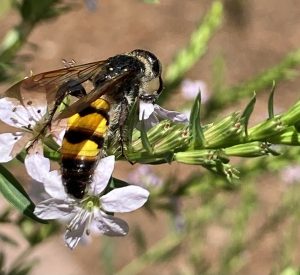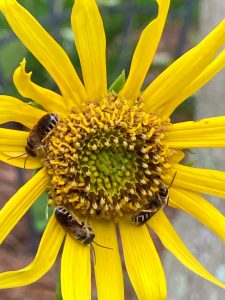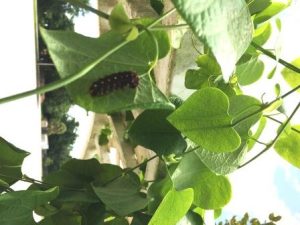 Landscapes that support our native pollinators are places filled with wonder! They help our environment by providing safe havens for our smallest of wildlife – bees, butterflies and more! Homeowners, institutions, developers – even apartment dwellers with balconies – can experience the reward of knowing that individuals CAN make a difference! Florida’s pollinators have life cycles that span the entire year. By following a few simple guidelines during the changing seasons, they will become a vital part of your landscape year after year!
Landscapes that support our native pollinators are places filled with wonder! They help our environment by providing safe havens for our smallest of wildlife – bees, butterflies and more! Homeowners, institutions, developers – even apartment dwellers with balconies – can experience the reward of knowing that individuals CAN make a difference! Florida’s pollinators have life cycles that span the entire year. By following a few simple guidelines during the changing seasons, they will become a vital part of your landscape year after year!
If you are new to the idea of gardening for pollinators, don’t feel intimidated! You do not need to be a scientist to succeed, and you don’t have to create a park-like formal garden! For many residents, a great place to start is to reduce large areas of turfgrass and create a plant bed. Adding a diversity of plants in this area – from trees and shrubs to wildflowers – will provide an environment in which our pollinators can thrive! No room? No problem! Many nectar plants make great container gardens!
Florida’s Pollinators will thrive in a landscape that provides:
Nectar: from blooming flowers
Shelter and places to raise their young: foliage, small piles of branches/twigs, small rocks
Water: shallow containers with small rocks for perching, kept clean and refreshed frequently
Pesticide-free zone
Tips for year-round pollinator support
SPRING
Springtime is a busy time in a pollinator garden! Prolific blooms are visited by hungry and busy pollinators as they go about their business of sipping nectar and gathering pollen for this active season.
Plant suggestions: tea bush, snow square stem, pentas, chastetree, native firebush, button sage lantana, simpson’s stopper, native viburnum species, Texas sage, coreopsis, Salvia species, greeneyes, black-eyed Susan, stokes aster, zinnia, Verbena and many more!
***Specific for attracting butterflies: Plant host plants (those on which butterflies will lay their eggs; these plants are specific to each butterfly species). Suggestions: pawpaw, passionvine, Senna species, native milkweed, purple meadow beauty, golden alexander, dill, parsley, and more!
Remember to provide a shallow water source (a shallow bird bath with rocks for perches). Keep this fresh and clean, replenishing frequently.
SUMMER TO FALL
During the heat of summer, many of the above nectar plants will continue to bloom. Other hot weather plants to consider: spotted bee balm, Buddleia, rattlesnake master, native mistflower, Plumbago, sunflowers, bulbine, Gaillardia, native porterweed, dune sunflower and more!
Fall blooming plants are important nectar sources for resident and migrating pollinators! Some ideas: goldenrod species, fall-blooming Aster species, Liatris, Garberia, and more.
Remember water source, provide in shade if possible.
LATE FALL THROUGH WINTER
Pollinator activity decreases from late fall through winter. Many pollinators will create overwintering nests, either burrowing underground or in cavities of dormant stems; or in twigs, branches, and logs. Protect your pollinators in this critical time:
* Leave fallen tree leaves undisturbed and provide open sandy areas for ground-nesters.
* Leave piles of small twigs and branches and even a log or two for cavity-nesters.
* Leave dormant wildflower stems in place for cavity-nesters. Many of these stems are hollow or pithy and provide perfect “tunnels” for native bee homes.
* Don’t forget our migrating birds! If possible, provide trees and shrubs with seed pods, acorns, and berries. Provide a water source, keeping it refreshed frequently.
In late winter, provide early-season blooms for emerging and returning pollinators. Some plant ideas: sparkleberry, rusty Lyonia, dwarf powderpuff, senecio, lyre leaf sage, beautyberry, plum, sky blue clustervine.
Check out the following links for information on planting, maintaining, and enjoying your pollinator garden all year long!

Gardening for Butterflies in Central Florida
Butterfly Gardening in Florida
For more information, contact UF/IFAS Extension Polk County at (863) 519-1041 or visit us online at http://sfyl.ifas.ufl.edu/polk. The Plant Clinic is open Monday-Friday, 9:00 am-4:00 pm to answer your gardening and landscaping questions. Give us a call or email us at polkmg@ifas.ufl.edu.
If you are not in Polk County, Contact your local UF/IFAS Extension Master Gardener Volunteer Plant Clinic.
The Florida Master Gardener Volunteer Program is a volunteer-driven program that benefits UF/IFAS Extension and the citizens of Florida. The program extends the vision of the University of Florida/Institute of Food and Agricultural Sciences, all the while protecting and sustaining natural resources and environmental systems, enhancing the development of human resources, and improving the quality of human life through the development of knowledge in agricultural, human and natural resources and making that knowledge accessible.
This article was written by Master Gardener Volunteer Molly Griner under supervision of the Master Gardener Volunteer Coordinator and Residential Horticulture Extension Agent Anne Yasalonis.
An Equal Opportunity Institution.
 4
4
